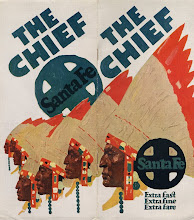Yehudis Benhamou first came to the Wolfsonian Library as a Master’s candidate at Florida International University, earning academic credit with an internship in our library. She returned yesterday morning leading a class of Hillel Community High School students studying the Second World War and the Holocaust. This was the last of a large number of school visits this month by teachers and students studying the subject. The Wolfsonian’s unparalleled collection of propaganda from this period has made us a popular field trip site for teachers.
The students at Hillel, like the Shenandoah Middle School students who visited earlier in the month, had the privilege of seeing a wealth of primary source materials laid out on the main reading room table. In trying to come to terms with the Holocaust, the Hillel students received a first-hand glimpse of the propaganda Hitler and the Nazis created to sow hatred and distrust of Jews in Germany and later in the territories occupied by the Germans during the Second World War.
In addition to fostering a German “master race” myth with images of beautiful and handsome Aryan-types, National Socialist propagandists also worked to create a counter-image aimed at uniting the country against a common enemy: the Jew. Ironically, before the Nazi seizure of power in 1933, one might have thought Germany the least likely European country to initiate an all-out war against the Jews. In the pre-Third Reich era, Jews had been emancipated, and the Jewish population had largely assimilated into German society, with high rates of Jewish-German intermarriage. Following Hitler’s rise to power, however, the National Socialist dictatorship began to foster and create stereotypes and unflattering images of Jews and other “degenerate” races to promote fear, distrust, and hatred of the supposed “enemies” of the Third Reich.
The Nazi campaign for “cleansing” the fatherland of foreign and “degenerate” cultural influences that began with the banning and burning of books and the publication of anti-Semitic propaganda, soon escalated into government-sanctioned harassment of Jews, the passage of racist legislation prohibiting intermarriage, the forced segregation of Jews into ghettos, and ultimately, deportation to so-called “work camps” during the Second World War.
The Wolfsonian has just this month received another donation to the collection of a pamphlet with a photomontage illustration by John Heartfield. Born in Berlin in 1891, Helmut Herzfeld became an ardent Communist, Anglicized his name to disassociate himself from the Nazis, and moved to neighboring Czechoslovakia following Hitler’s rise to power where he continued to satirize Fascism and Nazism. Rightly fearing a Nazi take-over, in 1938 he fled to England, ultimately returning to (East) Berlin after the war. Even as Heartfield used his artwork to counter Nazism and racial hatred in the 1930s, the Wolfsonian’s rich collection of political propaganda from this period will enable us to continue to educate present and future generations of students and to ensure that the world will not forget.
GIFT OF FRANCIS XAVIER LUCA &
CLARA HELENA PALACIO-DE LUCA



























